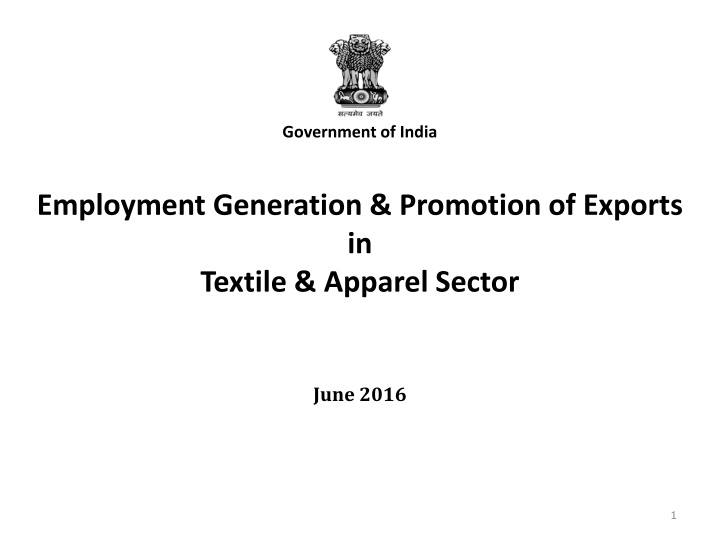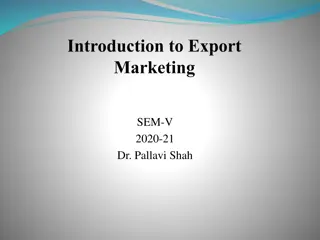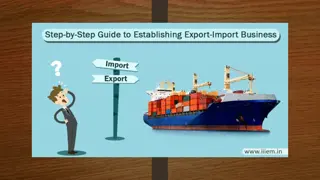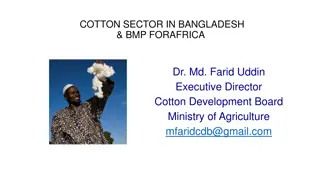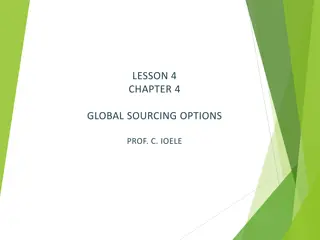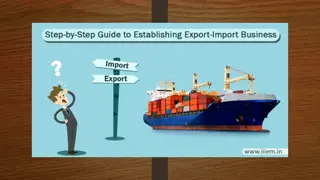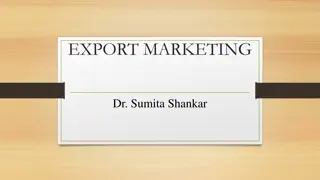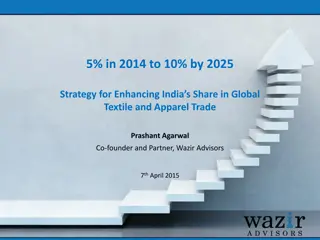Government of India Textile & Apparel Sector Employment Generation & Export Promotion - June 2016
This document outlines the export and employment potential in the textile and apparel sector in India. It discusses decisions on production and employment incentives, labor productivity incentives, and tax incentives. It also highlights the sectors' potential for employment generation, the current potential, and the additional employment opportunities. Furthermore, it addresses the challenges faced by India in apparel exports compared to Bangladesh and Vietnam and proposes strategies for enhancing production, employment, and labor reforms in the garment manufacturing sector.
Download Presentation

Please find below an Image/Link to download the presentation.
The content on the website is provided AS IS for your information and personal use only. It may not be sold, licensed, or shared on other websites without obtaining consent from the author.If you encounter any issues during the download, it is possible that the publisher has removed the file from their server.
You are allowed to download the files provided on this website for personal or commercial use, subject to the condition that they are used lawfully. All files are the property of their respective owners.
The content on the website is provided AS IS for your information and personal use only. It may not be sold, licensed, or shared on other websites without obtaining consent from the author.
E N D
Presentation Transcript
Government of India Employment Generation & Promotion of Exports in Textile & Apparel Sector June 2016 1
Outline I. Export & Employment Potential II. Decisions Production / Employment Incentives Labour Productivity Incentives Tax Incentives 2
Sectors Potential Incomparable employment potential of garmenting sector Every 1 crore rupees of investment generated a minimum of 70 jobs in garmenting sector as compared to 10 persons in steel & 25 persons in automobile sector Presence of the entire value chain in India from fibre to apparel manufacturing China ceding space due to focus on high technology sectors; and rising wage costs 3
Sectors Potential Current Potential Additional Employment Generation 31.9 Million 56.9 Million 25 Million Exports US$ 40 bn. US$ 57 bn. US$ 17 bn. *Investment required to balance the value chain = US$ 30 bn. Source: Calculations based on data published by Office of Textile Commissioner and industry estimates
Apparel exports of Bangladesh and Vietnam have surpassed India s apparel exports APPAREL EXPORTS (US$ BN) With policy support, India can again regain its position in next 3 years 43 40 37 37 34 Vietnam s apparel export exceeded that of India in 2011 32 31 Bangladesh s apparel export exceeded that of India in 2003 29 29 28 26 24 23 22 21 21 18 17 17 17 16 India was the clear leader from 1995 to 2000 15 13 15 14 14 14 11 9 11 11 11 11 9 10 10 10 8 8 8 6 8 Today India is the smallest apparel exporter among 3 7 4 6 6 5 5 5 5 5 5 5 5 India 5 4 4 4 1 4 4 1 4 3 1 3 1 3 1 2 Bangladesh Vietnam 2 Projections 2 Data Source: UN Comtrade
Production & Employment Incentives and Labour Reforms
Decision: Additional Employment in Garment Manufacturing Sector Tax and Production Incentives Reduction in number of working days from 240 to 150 under section 80JJAA of Income Tax Act ; Additional 10% ATUFS subsidy for garmenting : Scheme for three years In additional 15% being given at present Based on additional production and employment generated after a period of 3 years; Government to bear entire 12% of Employee Provident Fund Scheme contribution of employer including balance 3.67% contribution For all new employees enrolling in EPFO, for first three years; with salary up to Rs. 15,000 per month Bringing employees to formal sector Impact in three years: Increase in exports by 2.6 billion US$ increase in employment by 12.25 lakhs increase in investment by 7 billion US$ 7
Decision : Flexibility in Labour Laws to increase Productivity Overtime hours for workers not to exceed 8 hours per week in line with ILO norms Increased earnings to workers Introduction of Fixed Term Employment under Sub section 1 (15) of the Industrial Employment (Standing Order) Act, 1946 Benefits of regular employment Making employees contribution to EPF optional for employees earning less than Rs 15,000 per month Additional take home wages to employees; option of choice Impact in three years: Increase in exports by 1.4 billion US$ increase in employment by 1.75 lakhs increase in investment by 4.2 billion US$ 8
Decision : Additional Incentives under Duty Drawbacks for Garments Special scheme for remission of State levies by Ministry of Textiles for three years Rebate to be worked out by Drawback Committee Net additional outflow approximately Rs. 5500 crores Drawback at All Industries Rate should be given even when fabric inputs are imported under Advance Authorization Scheme AIR to be worked out by Drawback Committee Impact in three years: Increase in exports by 9.5 billion US$ increase in employment by 9.5 lakhs increase in investment by 2.7 billion US$ 10
Summary 3 year Impact Segment / Intervention Annual outgo Additional Investment (US$ bn.) Total Additional Exports (US$ bn.) Employment Direct & Indirect (Lakhs) Measures to Enhance Competitiveness of the Apparel Industry NIL 1.6 5.7 5.7 NIL 2.7 4.0 4.0 80JJAA Amendments Rs. 400 - 500 crores Additional TUFS for garmenting 2.6 12.25 7.0 Additional 3.67% EPF contribution Additional 5% duty drawback for garments Rs. 5,500 crores 2.7 9.5 9.5 Labour law reforms NIL 1.4 1.75 4.2 Direct employment :upstream segments @35% (yarn, fabric & processing) -- -- 10.7 Indirect employment* (1:1.3) -- -- 56.4 -- Total Rs. 6,000 crores 11.0 100.3 30.4 11
